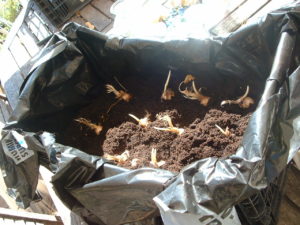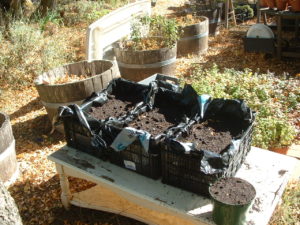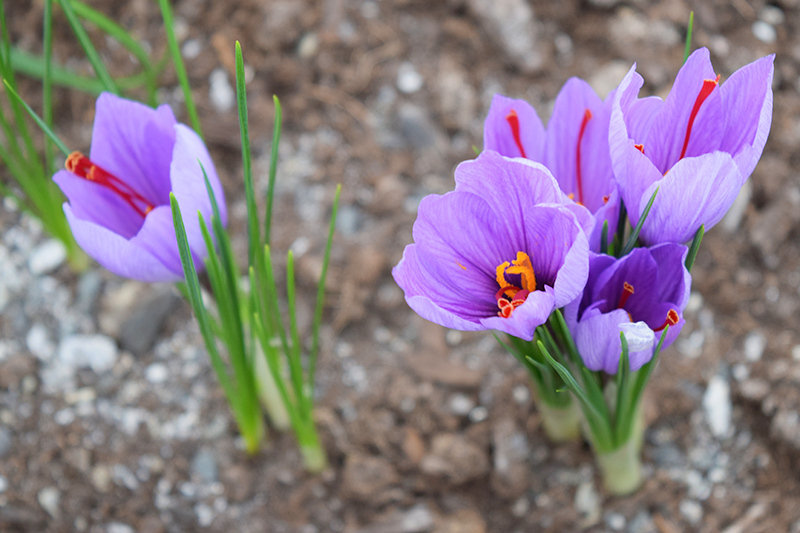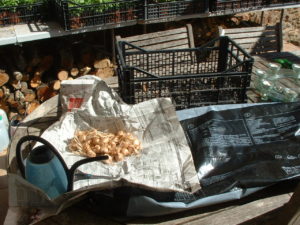Organic Saffron, Crocus Sativus, is the most expensive spice in the world. No wonder really when you realise that each saffron crocus gives only three stigma per year. Friends of mine have grown saffron and not a few of them have given up in despair.
It is not because saffron does not grown down here. It was originally from the Persia, Kashmir and Macedonia. The Arabs brought it to their Spanish caliphate. The climate of Les Corbieres is equally ideal for saffron growing, There are couple over Villeneuve des Corbieres that are growing a small parcel of saffron. BioSivam Aude have three registered organic growers. There is nothing particularly difficult apparently in growing saffron.
But the issue that finally made my friends stop was weeds. The saffron crocus is minute, really diddy. It can be over taken by weeds very quickly. Weeds compete for root space, dwarf the plants and make harvesting, already a pain staking process, nearly impossible. Harvesting is usually done at night, or first thing in the morning before the sun has risen, with the harvester, equipped with a caver’s lamp shuffling along on their knees hand picking each stigma.
Still I have always loved the idea of saffron. It is not logical, profitable or practical but so what?
Last Saturday instead of going to the local producers market in Perpignan I went to Fête Paysanne d’Automne in Azillanet . It was a lovely little event that dragged the hippies out of the surrounding Minervois and the Montagne Noire. For lunch they have a couple of food stands, one doing organic burgers, which did not appeal as they were wrapped in bread- not so good for a ceoliac- the other was a saffron producer cooking gambas and chicken kebabs with rice and a saffron sauce. It sounded delicious and their was no queue, the burger queue was huge. The French may talk the talk about slow food but there are more pizzerias in France than Italy, and France is the second most profitable market in Europe for McDonalds.
When I returned my plate, and gave the chef a glass of wine as way of thanks for a great lunch, they gave me a bundle of saffron corms.
This morning researching saffron on the internet I stumbled across The American Meadows Blog, particularly this post, How to Grow Saffron, about the work of researcher Arash Ghalehgolabbehbahani. He has worked on methods for growing saffron in containers. This seemed to be an ideal solution to the weed issue, although it does of course make it quite work intensive at the beginning;
So here is what I did this morning. I took a plastic box, the type that they use to transport lettuces from Spain up here. They throw them away at the end of market. An empty soil sack, and the corms.
 I cut the soil sack down the side and bottom and filled the salad box with it. I then mixed our garden soil, old plant soil from plants I had thrown away, and new organic plantation soil to a depth of about 2/3rds of the box. I placed 15 corms in each box, around 6 cms apart. Root side down naturally
I cut the soil sack down the side and bottom and filled the salad box with it. I then mixed our garden soil, old plant soil from plants I had thrown away, and new organic plantation soil to a depth of about 2/3rds of the box. I placed 15 corms in each box, around 6 cms apart. Root side down naturally
 I covered then gentle covered the saffron corms with new organic plantation soil, about 8 to 10 centimeters on top of them. I made sure the top soil was crumbled down quite fine. Some of corms were already sprouting, and I wanted to ensure that the young sprouts would find it quite easy to push through. I found a place that gets the sun in the morning but not the full heat of the afternoon. In may be mid October but it is promising to get up to 29C this afternoon. Once in place they all got a good watering.
I covered then gentle covered the saffron corms with new organic plantation soil, about 8 to 10 centimeters on top of them. I made sure the top soil was crumbled down quite fine. Some of corms were already sprouting, and I wanted to ensure that the young sprouts would find it quite easy to push through. I found a place that gets the sun in the morning but not the full heat of the afternoon. In may be mid October but it is promising to get up to 29C this afternoon. Once in place they all got a good watering.
The corms were not organically certified, so neither will be our saffron. Not this year, nor next year. Subject to analysis to ensure that there is no trace of chemicals, hopefully the year after that. Well sprouting would be a good start.
Watch this blog for news.



This is a fascinating study on the most effective methods for drying saffron
“Abstract:
The substances responsible for saffron’s characteristic quality are crocins, picrocrocin, and safranal. The drying process is critical to the saffron quality as measured by levels of secondary metabolites, crocin (color and anti-tumor properties), picrocrocin (taste), and safranal (aroma). Four different dehydration methods were evaluated: Iranian traditional method (room temperature); dehydration with electrical oven at different temperatures; and dehydration with microwave at different powers. The results showed that the highest coloring strength was obtained when saffron treated at higher temperatures and lower times. Also the higher amount of safranal (aroma) and crocin (color) was obtained at high temperature. There was not significant difference between the amounts of picrocrocin at different temperatures in all drying methods. Between these methods, drying with microwave at 1000 W and drying at room temperature obtained the highest the lowest results respectively.”
The full document can be downloaded free here http://en.journals.sid.ir/ViewPaper.aspx?FID=84320126212